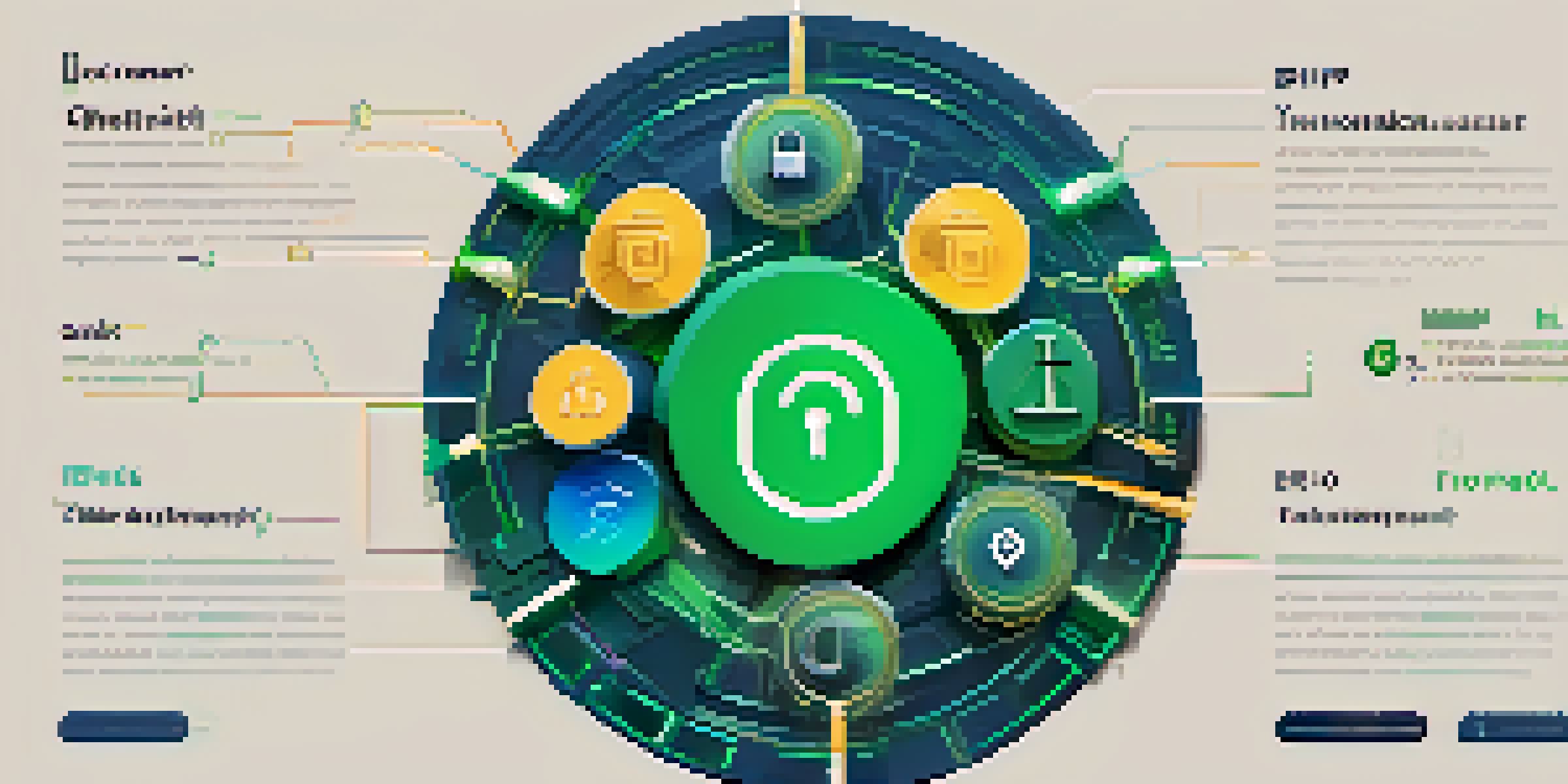Exploring Different Types of Token Lock-up Structures Available

Understanding Token Lock-up: A Brief Overview
Token lock-up refers to a mechanism used to restrict the transfer of tokens for a certain period. This is commonly seen in Initial Coin Offerings (ICOs) where early investors are unable to sell their tokens immediately. The primary goal is to prevent market flooding that could lead to price instability. By locking tokens, projects aim to foster trust and show commitment to their long-term vision.
In the world of cryptocurrency, trust is built on transparency and commitment.
For instance, if a new blockchain project raises funds through an ICO and immediately allows investors to sell their tokens, it can lead to a rapid drop in price. By implementing a lock-up period, teams can ensure that investors remain committed to the project's success. This strategy not only stabilizes the market but also encourages a healthy ecosystem for token holders.
In summary, understanding token lock-ups is crucial for anyone involved in cryptocurrency investments. It sets the stage for how tokens can be utilized and provides insights into the project's stability and investor confidence.
Fixed Token Lock-up: Simplicity at Its Best
A fixed token lock-up structure is straightforward, where tokens are locked for a predetermined duration. Once the lock-up period expires, tokens are released to holders without any conditions. This model is often favored by projects looking to convey transparency and simplicity to their investors.

For example, a project might announce a one-year lock-up for its team and early investors, ensuring that everyone has a vested interest in the project's success during that period. This clear timeline helps build trust and allows investors to plan their financial strategies accordingly. However, while this structure is easy to understand, it may not always cater to the dynamic nature of the cryptocurrency market.
Token Lock-ups Stabilize Markets
Token lock-ups prevent immediate selling, which helps maintain price stability and fosters trust in cryptocurrency projects.
In conclusion, fixed lock-ups serve as a reliable method for managing token release schedules, although they may lack the flexibility some investors desire in a rapidly changing environment.
Vesting Periods: Gradual Token Release Explained
Vesting periods are designed to release tokens gradually over a specified timeframe, often tied to performance milestones. This structure ensures that stakeholders, such as team members and advisors, remain incentivized to contribute positively to the project. By tying token release to performance, projects can align the interests of all parties involved.
Flexibility in strategy is essential for success in a volatile market.
For instance, a project might implement a four-year vesting schedule where tokens are released quarterly. This method not only helps to stabilize token value but also encourages ongoing engagement from the team as they work towards achieving specific goals. By having a vested interest in the project's success, stakeholders are less likely to abandon ship.
Ultimately, vesting periods can be beneficial for both projects and investors, fostering a culture of responsibility and commitment while ensuring that tokens are distributed in a controlled manner.
Cliff Periods: The Waiting Game
A cliff period is a unique feature often associated with vesting schedules, where tokens are locked for an initial period before any are released. This means that stakeholders must wait for a specified time before they can access even a portion of their tokens. Cliff periods are particularly effective in ensuring that team members stay with the project long enough to contribute meaningfully.
For example, a project might have a one-year cliff, followed by a gradual release of tokens over the next three years. This setup not only motivates team members to remain committed but also demonstrates to investors that the team is in it for the long haul. The initial waiting period acts as a buffer against quick sell-offs right after the project launches.
Vesting Encourages Commitment
Vesting periods tie token release to performance milestones, ensuring stakeholders remain engaged and incentivized to contribute.
In essence, cliff periods can help create a sense of stability and trust, allowing projects to build a solid foundation before distributing tokens to key stakeholders.
Dynamic Lock-up Structures: Adapting to Market Changes
Dynamic lock-up structures allow for flexibility in token release based on market conditions or specific milestones. Unlike fixed structures, these systems can adapt to changing circumstances, making them appealing in the volatile world of cryptocurrency. This adaptability can be beneficial in ensuring that the project remains responsive to its investors' needs.
For instance, a project might implement a dynamic lock-up that releases tokens based on the achievement of certain performance metrics, such as user growth or revenue targets. This ensures that tokens are distributed in a way that reflects the project's success, allowing for a more sustainable growth trajectory. Investors may feel more secure knowing that token release is contingent on tangible progress.
Ultimately, dynamic lock-ups can provide a balance between investor interests and project needs, making them a compelling choice for innovative blockchain projects.
Multi-Sig Wallets: Securing Token Lock-ups
Multi-signature (multi-sig) wallets are a security feature that requires multiple approvals before any transaction can be made, adding an extra layer of protection to token lock-ups. This method ensures that no single individual has complete control over the tokens, which can help prevent fraud or mismanagement. Multi-sig wallets are particularly popular in decentralized finance (DeFi) projects.
For example, a project might set up a multi-sig wallet where three out of five stakeholders must approve any token release. This collaborative approach not only enhances security but also fosters accountability among team members. It creates a more democratic process for managing the project's assets and ensures that decisions are made collectively.
Dynamic Structures Adapt to Change
Dynamic lock-up structures allow token release to adjust based on market conditions, balancing project needs with investor interests.
In summary, multi-sig wallets can significantly improve the security and transparency of token lock-ups, making them a preferred choice for many projects looking to build trust with their community.
Conclusion: Choosing the Right Structure for Your Project
Choosing the right token lock-up structure is crucial for the success of any cryptocurrency project. Each type of lock-up mechanism has its own benefits and drawbacks, and the best choice will depend on the specific goals and needs of the project. Understanding these structures can help investors and project teams align their expectations and strategies effectively.
For instance, if a project aims to establish long-term commitment among its team, a vesting period with a cliff might be ideal. Conversely, if the project is in a rapidly evolving market, a dynamic lock-up structure could provide the flexibility needed to adapt. Ultimately, the chosen structure should reflect the project's vision while ensuring investor confidence.

In conclusion, taking the time to explore different token lock-up structures can lead to better decision-making and a more successful outcome for all stakeholders involved.